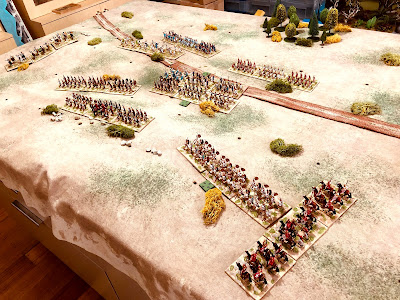One thing I forgot to cover in my previous post about the setup of this game was the order of battle. The make up of units is determined by a table and a dice roll (see here) and Cartage must choose one Gaul unit as an alternative to heavy infantry. The limit of seven units is because I am continuing to use 3 base units which give a unit frontage of 12 inches. I have continued using larger units for two reasons: 1) I like the look, and 2) they make the units quite unwieldy on the tabletop unless they are moving forward or retiring backwards.
Carthage
- Hannibal exceptional commander
- 1 x Warband (Gauls)
- 3 x Heavy Infantry
- 1 x Light Cavalry
- 1 x Heavy Cavalry
- 1 x Light Infantry
Rome
- 2 x Light Infantry
- 4 x Heavy Infantry
- 1 x Heavy Cavalry
 |
| Deployed Armies with the Romans nearest. All units have 3 bases. |
The Romans have the opportunity to move first because they began deploying their units first (see previous post). They take this opportunity to move their cavalry onto a small hill on their left flank. Carthage charges forward with their Gauls and heavy cavalry on the opposite flank near the town. An initiative chance card allows for a swift advance and Roman light infantry are caught up in a melee and are quickly eliminated. The Roman commander moves one heavy infantry unit from the hill to counter the threat from the Gauls.
 |
| The opening moves as both sides pushed forward on opposite flanks. An early melee occurs in the centre between Rome's light infantry and Carthage's heavy infantry. |
 |
| Roman light infantry are quickly eliminated as Carthaginian units advance. |
Fate, or the chance cards, were being very fickle to the Romans who were drawing confusion cards and no rally cards. Lots of rally cards would hopefully appear soon, but you cannot rally eliminated units. They have lost their light infantry and heavy cavalry, which had eventually succumbed to an attacking combination of light cavalry supported by light infantry. Not that luck had gone all Carthage's way. They had lost their Gauls and were making heavy work of it in the centre.
 |
| The Roman centre is holding firm, but the Carthaginians have been able to secure both flanks. |
The Carthaginians using their flanking and numbers advantage pin Roman units with a frontal attack and have a second unit attack the flanks. Responding to this remaining Roman heavy infantry on their large hill reposition their forces for the next wave of Carthaginian attacks.
 |
| Roman forces pullback to defend the large hill and Carthaginian units reorganise. |
Even with rally chance cards being quite plentiful for Rome in the latter part of the game to reduce their hits. The Carthaginian numbers and flanking units were able to concentrate and slowly pick off the remaining Roman units.
A victory to Carthage.
 |
| Carthaginians attack on all sides and Roman forces are eventually defeated. |
This loss in Southern Italy does not bode well for Rome's future. They will desperately need a win in this region during the next campaign turn, otherwise they will not have the ability to recruit as Carthage's control increases.
 |
| Campaign map at the end of turn 2. |
Very nice, your 3 base units look superb and army size is a good counter-balance to get that effect. I am interested to see how Carthaginian Cavalry (mainly Numidian) behave in your games, as I have just been playing a system in which they are very powerful .... perhaps too powerful! and it seems the Roman flanks will always fall to them.
ReplyDeleteHi Norm, I will probably be posting in a few weeks an update to the D3 rules I have been using. I keep the rules the same for all light cavalry, but allow veteran or exceptional units (eg Numidian cavalry) to do a re-roll and the re-rolled score must be accepted. That way with the D3 dice, you tend to re-roll a 1, but accept scores or 2. Thanks, Peter
DeleteThis does look grim for Rome - is this the point where you reveal the 'special rule'? The one where Rome can always raise an Army in either (or both?) Northern or Southern Italy even if not outnumbering the Carthaginians there (stacking limits still apply). This must be what Hannibal must've thought was going on at times.
ReplyDeleteI was pondering about whether to bring in any additional rules if the campaign looks to end too early. I do like the suggested home base recruitment rule.
DeleteAnother fine battle, it's looking a bit bleak for the Romans now. I remember when I was very keen on DBA the Romans defeated everyone until they met the Carthaginians. Then the battles were about 60/40 in favour of the Carthaginians, it was a revelation for me at the time.
ReplyDeleteRegards,
Paul.
At the start of the game I thought Rome had a good chance until they were outflanked. I am now considering the flanking advantage in the rules which doubles the hits is too much of an advantage.
DeleteLike you and the others, I thought that Rome had the pick of the terrain and troops, but did not bank on Hannibal's clever out-flanking. The Romans ended up being the filling in a fine sandwich!
ReplyDeleteRegards, James
Hi James, I too thought the Romans would win, but once you get flanked the problems begin.
Delete